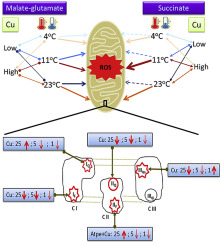当前位置:
X-MOL 学术
›
Free Radical Bio. Med.
›
论文详情
Our official English website, www.x-mol.net, welcomes your
feedback! (Note: you will need to create a separate account there.)
Effects of copper and temperature on heart mitochondrial hydrogen peroxide production.
Free Radical Biology and Medicine ( IF 7.1 ) Pub Date : 2019-12-09 , DOI: 10.1016/j.freeradbiomed.2019.12.006 Michael O Isei 1 , Collins Kamunde 1
Free Radical Biology and Medicine ( IF 7.1 ) Pub Date : 2019-12-09 , DOI: 10.1016/j.freeradbiomed.2019.12.006 Michael O Isei 1 , Collins Kamunde 1
Affiliation

|
High energy demand for continuous mechanical work and large number of mitochondria predispose the heart to excessive reactive oxygen species (ROS) production that may precipitate oxidative stress and heart failure. While mitochondria have been proposed as a unifying cellular target and driver of adverse effects induced by diverse stressful states, there is limited understanding of how heart mitochondrial ROS homeostasis is affected by combinations of stress factors. Thus, we probed the effect of copper (Cu) and thermal stress on ROS (as hydrogen peroxide, H2O2) emission and elucidated the effects of Cu on ROS production sites in rainbow trout heart mitochondria using the Amplex UltraRed-horseradish peroxidase detection system optimized for our model. Mitochondria oxidizing malate-glutamate or succinate were incubated at 4, 11 (control) and 23 °C and exposed to a range (1-100 μM) of Cu concentrations. We found that the rates and patterns of H2O2 emission depended on substrate type, Cu concentration and temperature. In mitochondria oxidizing malate-glutamate, Cu increased the rate of H2O2 emission with a spike at 1 μM while temperature had no effect. In contrast, both temperature and Cu increased the rate of H2O2 emission in mitochondria oxidizing succinate with a prominent spike at 25 μM Cu. The rates of H2O2 emission at the three temperatures during the spike imposed by 25 μM Cu were of the order 11 > 23 > 4 °C. Interestingly, 5 μM Cu supressed H2O2 emission in mitochondria oxidizing succinate or malate-glutamate suggesting a common mechanism of action independent of substrate type. In the absence of Cu, the site-specific capacities of H2O2 emission were: complex III outer ubiquinone binding site (site IIIQo) > complex II flavin site (site IIF) ≥ complex I flavin site (site IF) > complex I ubiquinone-binding site (site IQ). Rotenone marginally increased succinate-driven H2O2 emission suggesting either the absence of reverse electron transport (RET)-driven ROS production at site IQ or masking of the expected rotenone response (reduction) by H2O2 produced from other sites. Cu acted at multiple sites in the electron transport system resulting in different site-specific H2O2 emission responses depending on the concentration. Specifically, site IF H2O2 emission was suppressed by Cu concentration-dependently while H2O2 emission by site IIF was inhibited and stimulated by low and high concentrations of Cu, respectively. Additionally, emission from site IIIQo was stimulated by low and inhibited by high Cu concentrations. Overall, our study unveiled distinctive effects and sites of modulation of mitochondrial ROS production by Cu with implications for cardiac redox signaling networks and development of mitochondria-targeted Cu-based drugs.
中文翻译:

铜和温度对心脏线粒体过氧化氢产生的影响。
对连续机械工作的高能量需求和大量的线粒体使心脏容易产生过多的活性氧(ROS),从而可能导致氧化应激和心力衰竭。虽然线粒体已被提出作为统一的细胞靶点和各种压力状态引起的不良反应的驱动因素,但对线粒体ROS稳态如何受多种压力因素影响的认识仍然有限。因此,我们使用经优化的Amplex UltraRed-辣根过氧化物酶检测系统,探讨了铜(Cu)和热应力对ROS(过氧化氢,H2O2)排放的影响,并阐明了Cu对虹鳟心线粒体中ROS产生部位的影响。我们的模型。将线粒体氧化苹果酸-谷氨酸盐或琥珀酸盐在4℃下孵育 11(对照)和23°C,并暴露于一定范围(1-100μM)的Cu浓度下。我们发现,H2O2的排放速率和模式取决于基质类型,Cu浓度和温度。在线粒体氧化苹果酸-谷氨酸的过程中,Cu以1μM的峰值增加了H2O2的排放速率,而温度则没有影响。相反,温度和铜都增加了线粒体氧化琥珀酸中H2O2的释放速率,在25μMCu处有一个明显的尖峰。在由25μMCu施加尖峰期间,在三个温度下H2O2的排放速率为11> 23> 4°C。有趣的是,5μMCu抑制了线粒体氧化琥珀酸或苹果酸-谷氨酸的线粒体H2O2的释放,这提示了与底物类型无关的共同作用机理。在没有铜的情况下,H2O2排放的特定位置容量为:复合物III外部泛醌结合位点(位点IIIQo)>复合物II黄素位点(位点IIF)≥复合物I黄素位点(位点IF)>复合物I泛醌结合位点(位点IQ)。鱼藤酮在一定程度上增加了琥珀酸盐驱动的H2O2排放,表明在IQ位点没有反向电子传输(RET)驱动的ROS产生,或从其他位点产生的H2O2掩盖了预期的鱼藤酮反应(减少)。铜作用于电子传输系统中的多个位点,根据浓度的不同,会产生不同的位点特异性H2O2发射响应。具体地,位点IF H 2 O 2的排放被Cu浓度依赖性地抑制,而位点IIF的H 2 O 2排放分别被低和高浓度的Cu抑制和刺激。此外,低浓度Cu会激发IIIQo站点的发射,而高浓度Cu会抑制它的发射。总体而言,我们的研究揭示了铜对线粒体ROS产生的独特作用和调控位点,这对心脏氧化还原信号网络和线粒体靶向铜基药物的开发具有重要意义。
更新日期:2019-12-09
中文翻译:

铜和温度对心脏线粒体过氧化氢产生的影响。
对连续机械工作的高能量需求和大量的线粒体使心脏容易产生过多的活性氧(ROS),从而可能导致氧化应激和心力衰竭。虽然线粒体已被提出作为统一的细胞靶点和各种压力状态引起的不良反应的驱动因素,但对线粒体ROS稳态如何受多种压力因素影响的认识仍然有限。因此,我们使用经优化的Amplex UltraRed-辣根过氧化物酶检测系统,探讨了铜(Cu)和热应力对ROS(过氧化氢,H2O2)排放的影响,并阐明了Cu对虹鳟心线粒体中ROS产生部位的影响。我们的模型。将线粒体氧化苹果酸-谷氨酸盐或琥珀酸盐在4℃下孵育 11(对照)和23°C,并暴露于一定范围(1-100μM)的Cu浓度下。我们发现,H2O2的排放速率和模式取决于基质类型,Cu浓度和温度。在线粒体氧化苹果酸-谷氨酸的过程中,Cu以1μM的峰值增加了H2O2的排放速率,而温度则没有影响。相反,温度和铜都增加了线粒体氧化琥珀酸中H2O2的释放速率,在25μMCu处有一个明显的尖峰。在由25μMCu施加尖峰期间,在三个温度下H2O2的排放速率为11> 23> 4°C。有趣的是,5μMCu抑制了线粒体氧化琥珀酸或苹果酸-谷氨酸的线粒体H2O2的释放,这提示了与底物类型无关的共同作用机理。在没有铜的情况下,H2O2排放的特定位置容量为:复合物III外部泛醌结合位点(位点IIIQo)>复合物II黄素位点(位点IIF)≥复合物I黄素位点(位点IF)>复合物I泛醌结合位点(位点IQ)。鱼藤酮在一定程度上增加了琥珀酸盐驱动的H2O2排放,表明在IQ位点没有反向电子传输(RET)驱动的ROS产生,或从其他位点产生的H2O2掩盖了预期的鱼藤酮反应(减少)。铜作用于电子传输系统中的多个位点,根据浓度的不同,会产生不同的位点特异性H2O2发射响应。具体地,位点IF H 2 O 2的排放被Cu浓度依赖性地抑制,而位点IIF的H 2 O 2排放分别被低和高浓度的Cu抑制和刺激。此外,低浓度Cu会激发IIIQo站点的发射,而高浓度Cu会抑制它的发射。总体而言,我们的研究揭示了铜对线粒体ROS产生的独特作用和调控位点,这对心脏氧化还原信号网络和线粒体靶向铜基药物的开发具有重要意义。











































 京公网安备 11010802027423号
京公网安备 11010802027423号